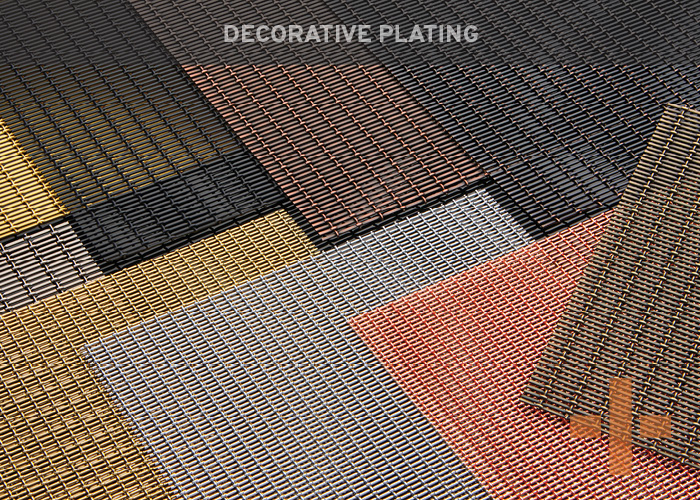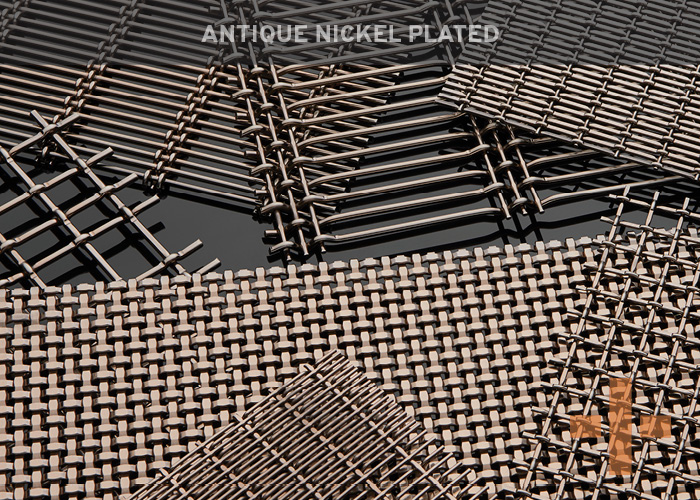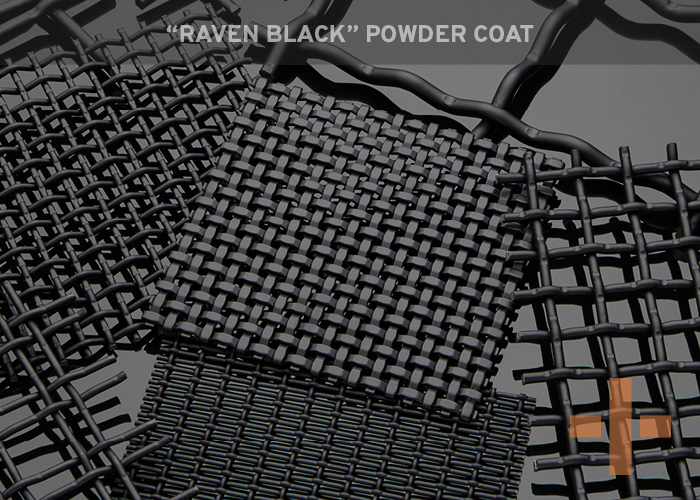Secondary Finishes
Banker Wire has researched a number of secondary finish processes that work well with woven and welded wire meshes. Since different materials react to varying local environments, such as bare steel rusting in wet conditions, appropriate finishes for interior and exterior applications should be considered. Many secondary finishes can be applied to help achieve the desired color, reflectivity, or corrosion resistance characteristics required.
Secondary Finishes for Wire Mesh
To enhance the appearance of the final product, we offer a variety of secondary finishes through our outside vendors – described in the next section.
Banker Wire is happy to assist in the early design stages. We can help identify the appropriate raw material for a desired secondary finish that fits the aesthetics of your project. Typical secondary finishes applied to the wire mesh include powder coating, decorative plating, passivation, US10B and US10A, as well as hot-dip galvanizing. When appropriate, Banker Wire can facilitate the specified finish and deliver the fabricated materials ready to install using our outside vendors. Please call us to discuss your next project design goals.
Please note: Specialty finishes on metal such as Antique Plating, US10A and US10B involve the human element during processing. With this, comes a degree of variability in the final outcome. Slight variations in darkness and brightness will exist from one production run to another. While Banker Wire does provide samples of these finishes, a level of deviation from these samples must be factored into the design decisions.
Banker Wire’s Standard Finish for Wire Mesh
Banker Wire manufactures all products in bare, mill finished condition within an industrial setting. A final cleaning should be considered after all fabrication and further processing is completed to ensure the material will look and perform at its best.
Our wire always complies with our high-expectations for quality and consistency. It should be noted that at times there may be subtle, varying degrees of light and dark shading in smooth, diamond drawn wire. While we make every attempt to minimize this with our quality controls and processes, inconsistencies are a natural occurrence of drawn wire and may still appear in the final product.
ABOUT SECONDARY FINISHES
Variations can occur in metal and with secondary finish operations. Pieces may vary slightly in tone and character from samples or previous orders and no guarantee can be made of an exact match.
Decorative Plating for Wire Mesh
Decorative plating is an electrodeposition process where a thin layer of brass, nickel, chrome, or copper is deposited on the wire mesh surface in a tank-dipped procedure. A decorative antique plated finish can really bring out the texture of a woven wire mesh in ways that other coatings cannot. The thin layer of metal does not mask the detail of the wire mesh but rather highlights it. The antique plated finish process introduces a dark oxide layer over top of the bright plated alloy. Then, visual depth is removed by a human with an abrasive pad to get the desired effect on the high points of the wire mesh allowing the bright plated alloy to show through. A thin layer of lacquer is applied after plating to help preserve the finish from further tarnishing.
Maximum Dimensions: 42″x96″
Appropriate wire mesh base alloys:
![]()
Corrosion resistance: Since the base alloy is bare steel, a decorative plated finish is not appropriate for exterior use. The plated finish will not adequately cover the “Wire on wire” areas that occur at the wire mesh intersections.
Wire mesh and frame assemblies: The plating process is a tank-dipped procedure. There are complications to sending a fabricated assembly through the plating process. Acid entrapment in the voids of the assembly can lead to bleed out. In some controlled situations, the plating process can be applied to wire mesh assemblies as long as there is adequate means of drainage during the rinsing process.
Special Considerations: The antique finishes undergo an abrasion process by hand to relieve the brighter alloy underneath the darker oxidized layer. The contrast between dark and bright alloy is unique to that of the various woven wire mesh patterns. The pictures above demonstrate how the different textures of the mesh patterns affect the same color finish. It should be noted that with any metal finish that is done by hand, a degree of variability will be inherent in the outcome. Samples of the finish will generally provide a good representation of color and detail however the brightness and darkness of the antique process may be different from job to job. This variability should be factored into the final design decision.
US10B and US10A Finish for Wire Mesh
The richness of wire mesh woven in bronze, brass, and copper brings unmatched color and warmth to your project. Banker Wire weaves all copper based alloys in a natural “mill finish”, “bare” condition. A secondary process must be introduced if the desired final finish is to be preserved in either a darkened (US10B) or satin (US10A) appearance.
US10B: The US10B finish darkens the bronze, brass, or copper followed by a clear lacquer top coat (for interior applications). Our standard offering targets visually enhancing the texture of the wire mesh pattern by darkening the wire and then physically relieving the highpoints.
US10A: The US10A finish physically removes the tarnish from the top layer of the bronze, brass, or, copper and seals it with a clear lacquer topcoat (For interior applications).
Maximum Dimension: 48″x96″, larger dimensions may be possible.
Appropriate alloys:
![]()
![]()
![]()
Corrosion resistance: US10A and US10B will resist tarnishing only with the lacquer top coat application that is standard in the process. Otherwise, without the lacquer, the wire mesh will continue to change dependent on its environmental surroundings. The standard lacquer topcoat is not recommended for exterior applications as it will not hold up to exterior elements and likely yellow and crack.
Special Considerations: US10A and US10B are not coatings. They are transformations of the existing base metal finish performed using a batch process. Deviations of color are inherent in these processes from job to job and no two metal finishers performing the same process are likely to arrive at the same color outcome. The time in solution, the base metal and the humidity in the area are just a few variables that prevent two separate outcomes to be the same. If consistency and a targeted color is what matters most to you, consider a powder coat that mimics the color instead like Prismatic Powders “Oil Rubbed Bronze”.
Powder Coating for Wire Mesh
Powder coating is a cost effective way to add an unlimited range of colors to wire mesh. Powder coating uses an electrostatic charge to attract a fluidized powder evenly across all surfaces of the wire mesh. The electrostatic charge holds the pigmented powder until it passes through an oven where it melts and adheres permanently to the wire mesh. After curing, the wire mesh has a colorful and durable coating that adds to the desired aesthetic of the project.
Appropriate wire mesh base alloys:
![]()
![]()
![]()
Corrosion resistance: Powder coating alone provides adequate corrosion protection provided it does coat the product 100%. However, wire mesh is unique in that the round sections of wire are assembled in an over, under fashion. The intersection points (wire on wire) of the wire mesh will therefore not be coated by powder and the material will not be completely protected against corrosion. For interior applications powder coating over bare steel is just fine because the mesh is unlikely to encounter environmental situations that would promote corrosion. If conditions exist where corrosion is a concern (Interior or Exterior) then the wire mesh base material specified becomes very important. The most cost-effective solution would be to use pre-galvanized steel wire as the base alloy; the zinc provides good corrosion protection at the metal on metal intersections where powder does not reach.
Wire mesh in frame assemblies: For exterior, fully fabricated wire mesh assemblies an E-coat primer application is highly recommended prior to the final powder coat finish. E-coating is an electrically charged wet primer paint process where the entire assembly is submerged. The positive and negative currents drive the wet E-coat into all of the small nooks of the frame assembly to ensures complete coverage. Powder cannot push itself into tight corners leaving areas exposed. E-coating is highly recommended as a primer level under powder coating when the frame assembly application is exterior. Powder coating requires that the assemblies provide adequate means of drainage during the rinsing process.
Special Considerations: When it comes to powder coating, not all powders are created equal. There are a variety of powder coat chemistries to choose from for specific environmental criteria, like epoxy, polyester, hybrid, and so on. It is important to understand the differences in powder coat chemistries and how the final product will be utilized, such as indoor or outdoors. When powder coating is determined as the secondary finish on Banker Wire mesh, the specifier will typically define the powder coat that is to be used.
Download Reference Sheet Care & Maintenance of Powder Coating
Passivation of Stainless Steel
In terms of aesthetics and corrosion resistance, stainless steel has all the right characteristics to make for beautiful wire mesh. However, stainless steel looks and performs its best when it is clean. The chromium content in stainless steel combines with oxygen in the air to create a natural passive chromium oxide layer. This chromium oxide layer protects the material from further corrosion. Contaminants of various kinds inhibit this passive oxide layer from developing to its fullest ability leaving the material susceptible to attack. A nitric or citric acid process (passivation) enhances the formation of this oxide layer allowing the stainless steel surfaces to be in an optimal “passive” state.
Rust on stainless: Rust developing on stainless steel is usually due to surface contamination of iron deposits embedded in the surface. Mechanical abrasions on stainless steel from non stainless tools is one common way iron contaminates exist on stainless steel. Once moisture is present, the iron embedded in the stainless steel will begin to rust. Steel bands used in directly strapping down the product to a skid is also a common means of contaminating the stainless steel. Before final install and after all processing of the material is complete a passivation process (such as nitric or citric acid) should be performed to remove any potential free iron that would otherwise corrode. Citric and nitric acid do not alter the appearance of stainless steel.
Appropriate wire mesh base alloys:
![]()

Corrosion resistance: Passivation using Nitric or Citric acid removes contaminates and builds the corrosion resistance ability of stainless to its fullest potential.
Wire mesh and frame assemblies: The passivation process should be performed only after all fabrication and assembly is complete.
Hot Dip Galvanizing (Galv After) for Wire Mesh
Hot dipped galvanizing is a process where bare steel is submerged into a tank of molten zinc. Wire mesh that undergoes this process is termed as hot dipped galvanized wire mesh or galv-after wire mesh. The molten zinc covers all surfaces of the wire mesh and provides a long lasting sacrificial layer that protects the steel from corrosion in some of the harshest conditions imaginable. It should be noted that this process does introduce an extreme temperature transition with molten zinc at over 800 degrees to cooling back down to room temperature. Welded wire mesh on its own can handle this temperature transition because each intersection is welded throughout the grid. Banker Wire recommends that with woven wire mesh, this process only be performed after a frame has been fully fabricated around the wire mesh to add structural stiffness. This stiffness will counteract mesh warpage.
Appropriate wire mesh base alloys:
![]()
Corrosion resistance: Wire mesh that is hot dipped galvanized will last for decades. The exact longevity of corrosion resistance does vary depending on its application surrounding however, the zinc coating provides a superior, maintenance free condition.
Wire mesh and frame assemblies: Hot dipped galvanizing should only be done once all welding, cutting, or grinding has been completed. Exposing any bare steel from the protection of the zinc layer will jeopardize the life of the product.
















